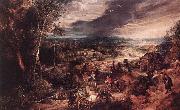
|
Artists
Index
|
||
|
RUBENS, Pieter Pauwel
|
||
|
The Martyrdom of St Livinus new18/RUBENS, Pieter Pauwel-754635.jpg Painting ID:: 51067 |
1633 Oil on canvas, 455 x 347 cm | |
| |
|
|
|
|
||
|
The Incredulity of St Thomas new18/RUBENS, Pieter Pauwel-839266.jpg Painting ID:: 51109 |
1613-15 Oil on wood | |
| |
|
|
|
|
||
|
Head of a Franciscan Friar new19/RUBENS, Pieter Pauwel-254286.jpg Painting ID:: 52048 |
Oil on canvas | |
| |
|
|
|
|
||
|
Summer new21/RUBENS, Pieter Pauwel-373798.jpg Painting ID:: 63045 |
142,8 x 222,8 cm Royal Collection, Windsor The painting is a companion scene to Winter (also in the Royal Collection), although it was only when both pictures were in the collection of Frederick, Prince of Wales, that they seem to have been treated as a pair. X-ray examination reveals that the priming on all the additional pieces of canvas is identical, but differs from that of the central section of this work. It appears that the design on the initial piece of canvas had not been fully resolved in all respects by the time the extra portions were added. The join on the left is on a line with the tall windswept trees, which seem to have been painted over the sky and therefore may be regarded as an adaptation of the original design, which most probably incorporated a clear view through to the horizon. On the right the design has been more radically changed as a result of the addition. A steep bank (still visible to the naked eye) originally closed the composition, but this was painted out so that the horizon could be extended in the upper half and a further group of farm buildings introduced in the middle distance. The addition along the lower edge allowed for the horse and cart in the immediate foreground. In effect, if the additions are discounted, the original composition remains an entity in its own right, but the changes alter the dynamics of the painting, placing greater emphasis on the peasants wending their way to market. The composition of Summer is distinguished. There is an emphasis on contrasting diagonals that reinforces the sense of movement begun by the figures in the foreground. The eye is plunged into the distance across a glorious landscape that is positively pantheistic in its celebration of nature (note the cow being mounted in the centre of the composition). Regardless of differences in scale and style, a telling comparison can be made between Summer and The Flemish Fair by Jan Brueghel the Elder. Interestingly, it has been suggested that the composition of Summer depends upon a lost painting by Pieter Bruegel the Elder entitled On the Way to Market, only known today through an anonymous drawn copy in the Staatliche Graphische Sammlung, Munich. Artist: RUBENS, Pieter Pauwel Painting Title: Summer , 1601-1650 Painting Style: Flemish , , landscape | |
| |
|
|
|
|
||
|
The Road to Calvary new21/RUBENS, Pieter Pauwel-532939.jpg Painting ID:: 63958 |
1634-37 Oil on canvas, rounded at the top, 569 x 355 cm Musees Royaux des Beaux-Arts, Brussels This painting was commissioned in 1634 for the high altar of the Abbey of Affligem, then one of the most important monasteries in the Low Countries. Tensions inside the monastery may explain why this monumental work was not delivered until 1637. In this production of his mature period, Rubens masterfully combines two artistic traditions. The first of these is that of the large single-frame altarpieces that were to replace the older polyptychs in the Southern Low Countries in the 17th century. With their exceptional scale and their strongly vertical format, they faced artists with the problem of constructing a convincing compositional unity from a series of related themes in a vertical format. As an artist gifted with one of the greatest compositional and narrative talents of his age, Rubens fulfilled his task masterfully. Instead of dividing the painting into an upper and lower register, a solution that he had often applied following Titian, he elects here to represent Christ's ascension to the place of his execution on Calvary in an uninterrupted zigzag movement. The thrust from below to above is achieved both in the colouring, with a balanced rhythm of localised concentrations of colour, and also iconographically, with the successive tableaux of the executioners with the two thieves, the holy women with Mary and Veronica, and ending with the Roman officers on horseback with their flapping pennants. The centre-point of the composition is Christ's face that St Veronica is wiping. Turned towards the viewer, it forms a direct call to the faithful to follow his life and to think on their own sins that had to be redeemed by Christ's suffering. This procedure descends directly from the tradition of devotional art, with small-scale pictures intended for individual meditation. The genius of Rubens' invention lies precisely in the combination of the two pictorial traditions, breathing new life into the ancient devotional tradition within a contemporary, counter-reformation form of altar decoration, whilst at the same time enriching the broad, sweeping movement of such a monumental high altarpiece with the more intimate emotionality of smaller devotional paintings. , Artist: RUBENS, Pieter Pauwel , The Road to Calvary , 1601-1650 , Flemish , painting , religiou | |
| |
|
|
|
|
||
| Prev artist Next artist | ||
|
Also Buy::. For Following Paintings / Artists / Products, Please Use Our Search Online: |











